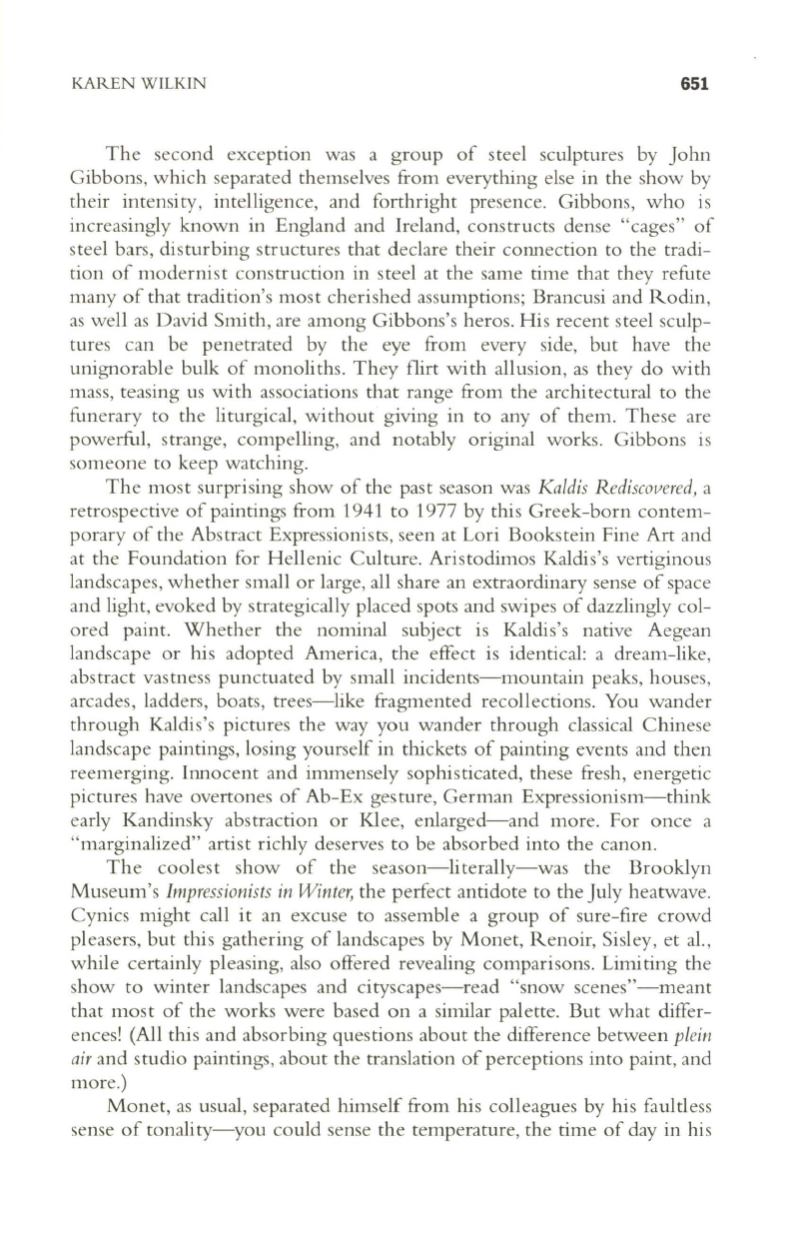
KAREN WILKIN
651
The second exception was a group of steel sculptures by John
Gibbons, which separated themselves from everything else in the show by
their intensi ty, intelligence, and forthright presence. Gibbons, who is
increasingly known in England and Ireland, constructs dense "cages" of
steel bars, disturbing structures that declare their connection to the tradi–
tion of modernist construction in steel at the same time that they refute
many of that tradition's most cherished assumptions; Brancusi and Rodin,
as well as David Smith, are among Gibbons's heros. His recent steel sculp–
tures can be penetrated by the eye from every side, but have the
unignorable bulk of monoliths. They flirt with allusion, as they do with
mass, teasing us with associations that range from the architectural to the
funerary to the liturgical, without giving in to any of them. These are
powerful, strange, compelling, and notably original works. Gibbons is
someone to keep watching.
The most surprising show of the past season was
Kaldis Rediscovered,
a
retrospective of paintings from 1941 to 1977 by this Greek-born contem–
porary of the Abstract Expressionists, seen at Lori Bookstein Fine Art and
at the Foundation for Hellenic Culture. Aristodimos Kaldis's vertiginous
landscapes, whether small or large, all share an extraordinary sense of space
and light, evoked by strategically placed spots and swipes of dazzlingly col–
ored paint. Whether the nominal subject is Kaldis's native Aegean
landscape or his adopted America, the effect is identical: a dream-like,
abstract vastness punctuated by small incidents-mountain peaks, houses,
arcades, ladders, boats, trees-like fragmented recollections. You wander
through Kaldis's pictures the way you wander through classical Chinese
landscape paintings, losing yourself in thickets of painting events and then
reemerging. Innocent and immensely sophisticated, these fresh, energetic
pictures have overtones of Ab-Ex gesture, German Expressionism-think
early Kandinsky abstraction or Klee, enlarged-and more. For once a
"marginalized" artist richly deserves to be absorbed into the canon.
The coolest show of the season-literally-was the Brooklyn
Museum's
Impressionists in Winter,
the perfect antidote to the July heatwave.
Cynics might call it an excuse to assemble a group of sure-fire crowd
pleasers, but this gathering of landscapes by Monet, Renoir, Sisley, et al.,
while certainly pleasing, also offered revealing comparisons. Limiting the
show to winter landscapes and cityscapes-read "snow scenes"-meant
that most of the works were based on a similar palette. But what differ–
ences! (All this and absorbing questions about the difference between
plein
air
and studio paintings, about the translation of perceptions into paint, and
more.)
Monet, as usual, separated himself from his colleagues by his faultless
sense of tonality-you could sense the temperature, the time of day in his


